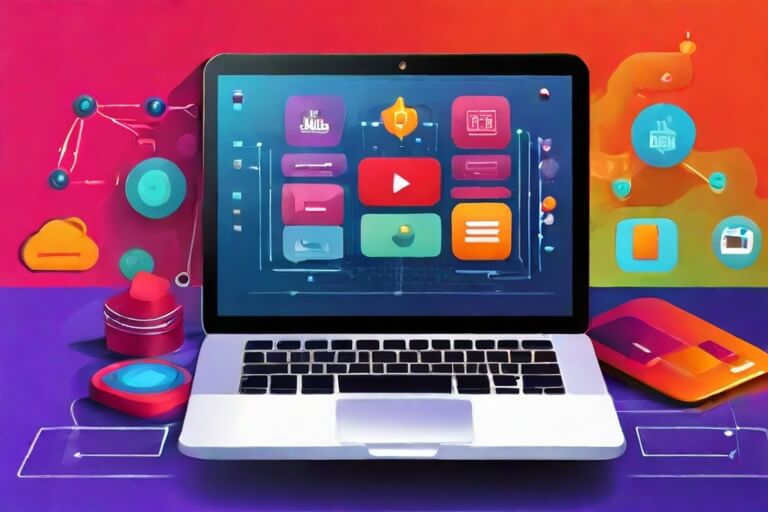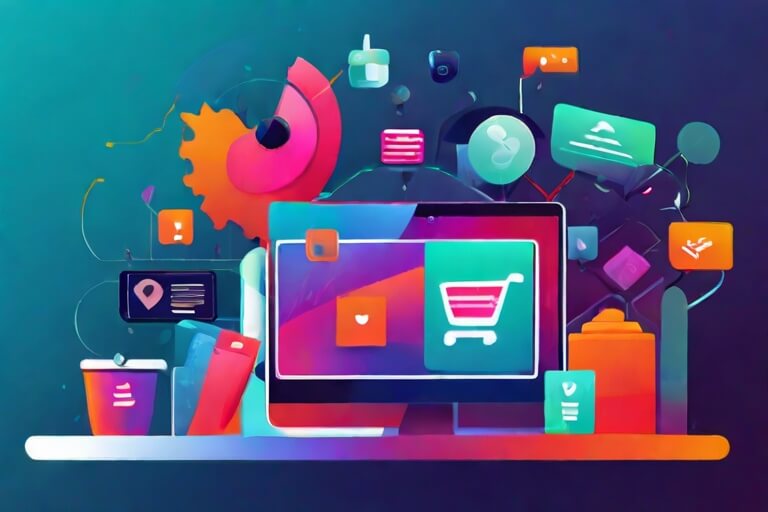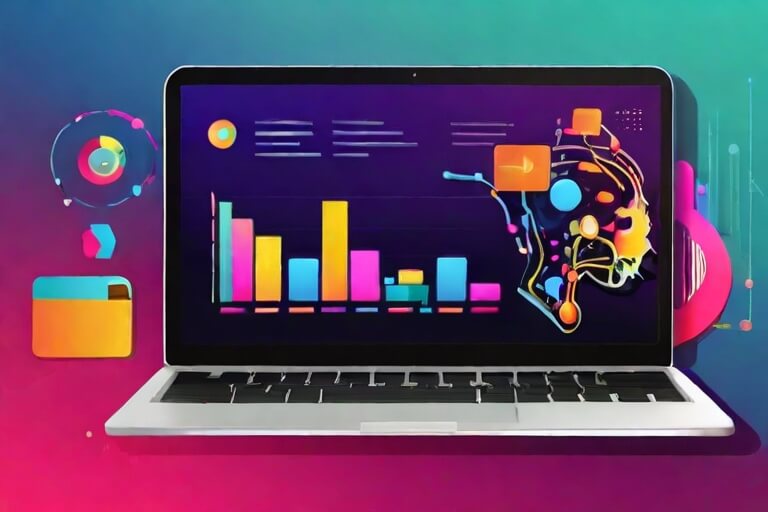TL;DR
- Analyzing data insights allows businesses to identify patterns, trends, and user preferences
- User behavior analysis helps in understanding how visitors navigate through landing pages
- Detailed analysis can determine which elements attract attention and which ones may cause users to leave
- Informed decisions on layout, content placement, and call-to-action design can be made based on data insights
- Monitoring key metrics such as bounce rate, time on page, and conversion rate is essential for tracking improvements
- Continuous iteration based on data-driven decisions leads to optimized landing pages
- Optimized landing pages result in improved user experience and higher conversions
- Utilizing data insights enhances the overall success of digital marketing efforts.
Artificial intelligence (AI) has transformed various industries, and its impact on digital product landing pages cannot be understated. With its ability to analyze vast amounts of data and make informed decisions, AI plays a crucial role in optimizing landing pages for better performance and conversions. By leveraging AI technology, businesses can create personalized experiences for their users, making it easier to engage and convert them into customers.
One of the key roles of AI in digital product landing pages is in optimizing content and design elements. AI algorithms can analyze user behavior, preferences, and demographic data to deliver personalized content that resonates with individual visitors. This level of personalization enhances user experience, increases engagement, and ultimately improves conversion rates. Additionally, AI can help identify underperforming elements on the landing page and suggest improvements, allowing businesses to constantly optimize their digital product offerings.
Key Metrics to Measure the Success of AI-Driven Landing Pages
To accurately gauge the effectiveness of AI-driven landing pages, it is crucial to determine the key metrics that can provide insightful data on their success. One such metric is the conversion rate, which measures the percentage of visitors who take the desired action, such as making a purchase or filling out a form. A high conversion rate indicates that the landing page is effectively engaging and persuading visitors to take the desired action. Tracking the bounce rate is equally important, as it identifies the percentage of visitors who leave the page without taking any action. A low bounce rate indicates that the landing page is successfully capturing and retaining the attention of visitors. Additionally, it is essential to measure the average time spent on the landing page, as it provides insights into how engaged visitors are with the content.
Crafting Compelling Copy for AI-Optimized Landing Pages
Crafting compelling copy for AI-optimized landing pages requires a delicate balance between human creativity and machine-driven analysis. While AI algorithms can provide valuable insights into user behavior and preferences, it is essential for marketers to infuse their unique brand voice and persuasive messaging into the copy. By understanding the target audience’s pain points, desires, and motivations, marketers can create engaging copy that resonates with potential customers.
When writing copy for AI-optimized landing pages, it is crucial to leverage data-driven insights to personalize the messaging. By analyzing user behavior, demographics, and preferences, AI algorithms can help identify patterns and trends that enable marketers to tailor their copy accordingly. This level of personalization not only enhances the user experience but also increases the chances of conversion. Moreover, by incorporating relevant keywords and phrases that are likely to be searched, AI-based algorithms can help optimize landing page copy for better visibility in search engine results. Such an approach not only ensures that the copy is compelling but also enhances its overall effectiveness in converting visitors into customers.
Designing Visually Engaging Elements for AI-Driven Landing Pages
In the age of digital marketing, designing visually engaging elements for AI-driven landing pages has become crucial for capturing customer attention and increasing conversions. With the rapid advancement of artificial intelligence technology, businesses can now leverage AI to optimize their landing pages and create visually stunning designs that resonate with their target audience.
One key aspect of designing visually engaging elements is to ensure a seamless user experience. AI algorithms can analyze user behavior and preferences to create personalized landing pages that cater to individual needs. By incorporating visually stimulating elements such as high-quality images, interactive videos, and captivating animations, businesses can create a visually appealing environment that keeps users engaged and encourages them to take desired actions.
Another important consideration is the use of color psychology in the design process. Different colors evoke different emotions and can influence user perception, making color selection a critical element in creating visually engaging landing pages. By utilizing AI algorithms and data insights, businesses can identify the color schemes that align with their brand identity and resonate with their target audience, thus enhancing the overall visual appeal and effectiveness of their landing pages.
Ultimately, by designing visually engaging elements for AI-driven landing pages, businesses can create a compelling digital presence that grabs attention, enhances user experience, and drives conversions. As AI technology continues to evolve, it is imperative for businesses to stay abreast of the latest trends and techniques in order to optimize their landing page performance and stay ahead of the competition.
Leveraging AI-Powered Personalization Techniques for Higher Conversions
Personalization is a powerful tool for improving conversions on digital product landing pages, and leveraging AI-powered techniques can take it to the next level. With AI, marketers can gather and analyze vast amounts of data to create highly personalized experiences for each user. By understanding the preferences, behaviors, and needs of each individual, AI can deliver tailored content, recommendations, and offers that are more likely to resonate with the target audience.
AI-powered personalization techniques can increase conversions by creating a sense of relevance and value for the user. Whether it’s through dynamically generated product suggestions based on browsing history or personalized messaging that addresses specific pain points, AI enables marketers to deliver a highly targeted experience. By leveraging AI algorithms to track and analyze user behavior, marketers can continuously fine-tune and optimize the personalization strategy for even higher conversion rates. In the next section, we will explore the various techniques and strategies that can be used to implement AI-powered personalization on digital product landing pages.
Implementing Advanced AI Algorithms to Optimize Landing Page Performance
In the rapidly evolving world of digital marketing, staying ahead of the competition requires implementing advanced AI algorithms to optimize landing page performance. These algorithms are designed to gather and analyze vast amounts of data, allowing businesses to gain a deeper understanding of their target audience and their preferences. By leveraging the power of AI, companies can not only deliver personalized experiences to users but also enhance their overall landing page performance.
With advanced AI algorithms, businesses can now automate and optimize various aspects of their landing pages, including layout, content, and design elements. By analyzing user behavior and engagement data, AI algorithms can identify patterns and trends that can be used to make data-driven decisions on optimizing landing page elements. This leads to improved user experiences, increased conversions, and ultimately, higher profitability for businesses. As AI continues to advance, companies can expect even more sophisticated algorithms that can adapt in real-time and provide personalized experiences to each individual user, further enhancing the performance of their landing pages.
Enhancing User Experience through AI-Driven Landing Page Optimization
To enhance user experience on landing pages, businesses are turning to AI-driven optimization strategies. AI algorithms can analyze user behavior and preferences, allowing businesses to personalize and tailor landing pages to individual users. By leveraging AI-powered personalization techniques, businesses can increase conversions and create a more engaging user experience.
One way AI can enhance user experience is through dynamic content generation. AI algorithms can analyze user data in real-time and generate customized content based on the user’s interests and preferences. This allows businesses to deliver relevant information and offers to the user, increasing the chances of conversion. Additionally, AI-driven landing page optimization can improve load times and overall page performance, reducing bounce rates and keeping users engaged. By utilizing AI algorithms to continuously analyze and improve landing pages, businesses can create a seamless and personalized user experience that drives conversions.
Strategies for A/B Testing and Iterative Improvements on AI-Optimized Landing Pages
Creating and implementing effective strategies for A/B testing and iterative improvements is crucial for optimizing AI-optimized landing pages. A/B testing allows marketers to compare two or more versions of a landing page and analyze which one performs better in terms of user engagement, conversions, and overall success metrics. By using A/B testing, marketers can identify areas that need improvement, make data-driven decisions, and continuously enhance the performance of AI-driven landing pages.
To ensure successful A/B testing, it is essential to define clear goals and objectives. Understanding what aspects of the landing page you want to improve and what metrics you want to measure will help guide your testing strategy. It is also crucial to test one variable at a time to accurately determine its impact on user behavior. Additionally, consider segmenting your audience to gain insight into how different user groups interact with your landing page. By conducting rigorous A/B testing and iterating based on data-driven insights, marketers can optimize AI-driven landing pages to deliver a more personalized and engaging user experience, leading to higher conversions and improved overall performance.
Integrating AI-Powered Chatbots for Enhanced Customer Engagement on Landing Pages
AI-powered chatbots have become increasingly popular in the realm of digital product landing pages. These intelligent and automated assistants play a crucial role in enhancing customer engagement and improving overall user experience. By integrating AI-powered chatbots into landing pages, businesses can offer seamless and personalized interactions with their website visitors.
One of the key advantages of incorporating AI-powered chatbots is the ability to provide instant and round-the-clock support to potential customers. Unlike human customer service representatives, chatbots can handle multiple conversations simultaneously, ensuring that no query goes unanswered. This not only saves time but also creates a sense of reliability and accessibility for users. Furthermore, AI-powered chatbots can be designed to understand and respond to natural language, making the interaction feel more conversational and human-like. This adds a personal touch to the user experience, ultimately leading to higher customer satisfaction and increased engagement on landing pages.
Analyzing and Utilizing Data Insights to Continuously Enhance AI-Driven Landing Pages
Gaining insights from data is crucial for continuously enhancing AI-driven landing pages. By analyzing the data generated from user interactions, businesses can identify patterns, trends, and user preferences. These findings can then be utilized to make data-driven decisions and implement optimizations that enhance the performance of landing pages.
One key aspect of analyzing data insights is understanding user behavior. Through detailed analysis, businesses can learn how visitors navigate through the landing page, which elements attract their attention, and which ones may cause them to leave. Armed with this knowledge, marketers can make informed decisions on layout, content placement, and call-to-action design, ensuring a seamless and user-friendly experience. By monitoring key metrics such as bounce rate, time on page, and conversion rate, businesses can track the effectiveness of these improvements and iterate as necessary.
In summary, the analysis and utilization of data insights play a critical role in continuously enhancing AI-driven landing pages. By understanding user behavior and making data-driven decisions, businesses can optimize their landing pages for improved user experience, higher conversions, and ultimately, greater success in their digital marketing efforts.
Frequently Asked Questions
What is the role of AI in digital product landing pages?
AI plays a crucial role in digital product landing pages by optimizing and enhancing the user experience, increasing conversions, and providing personalized content to potential customers.
What are the key metrics to measure the success of AI-driven landing pages?
Key metrics to measure the success of AI-driven landing pages include conversion rates, bounce rates, engagement metrics (such as time on page and click-through rates), and the overall impact on revenue or sales.
How can one craft compelling copy for AI-optimized landing pages?
Crafting compelling copy for AI-optimized landing pages involves understanding the target audience, highlighting unique selling propositions, incorporating persuasive language and calls-to-action, and conducting A/B testing to refine the messaging.
What are some strategies for A/B testing and iterative improvements on AI-optimized landing pages?
Strategies for A/B testing and iterative improvements on AI-optimized landing pages include testing different headlines, visuals, call-to-action buttons, layouts, and overall design elements to identify the most effective combinations for maximizing conversions.
How can one leverage AI-powered personalization techniques for higher conversions on landing pages?
Leveraging AI-powered personalization techniques involves analyzing user data and behavior to provide personalized content, recommendations, and offers tailored to individual users’ preferences and needs, ultimately increasing the likelihood of conversions.
How can advanced AI algorithms be implemented to optimize landing page performance?
Implementing advanced AI algorithms involves utilizing machine learning techniques to analyze data, identify patterns, and make data-driven optimizations such as dynamic content generation, real-time personalization, and automated A/B testing.
What are the benefits of integrating AI-powered chatbots for enhanced customer engagement on landing pages?
Integrating AI-powered chatbots on landing pages allows for immediate customer support, personalized assistance, and improved engagement by answering queries, providing relevant information, and guiding users through the conversion process.
How can data insights be analyzed and utilized to continuously enhance AI-driven landing pages?
Data insights can be analyzed by monitoring user behavior, tracking engagement metrics, conducting user surveys, and utilizing analytics tools. These insights can then be used to make data-driven decisions and implement iterative improvements to enhance the effectiveness of AI-driven landing pages.




